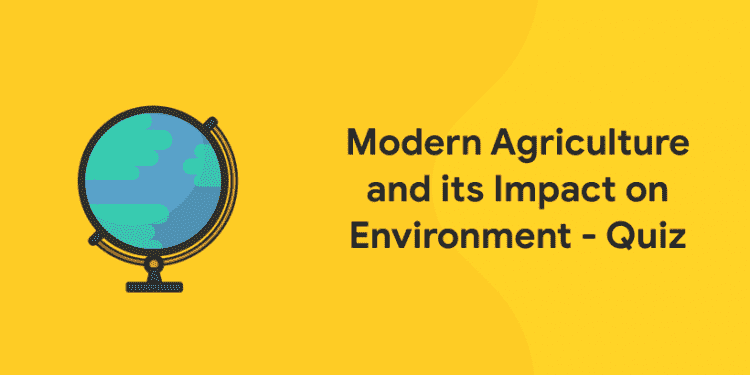Table of Contents
Agricultural methods have intensified continuously ever since the Industrial Revolution and even more since the “green revolution” in the middle decades of the 20th century. Meeting the demand for accelerated agricultural productivity is likely to be far more difficult than it has been so far. Modern agricultural practices usually are a term used to describe the wide majority of production methods used by farmers. According to recent studies, more than 90 percent of farmers embrace most innovative practices today, and other growing techniques to produce enough fuel, food, and fiber for a growing universe while minimizing their environmental impact at the same time. The term modern agriculture implies the advancement in terms of invention and innovation, stewardship, responsibility and meeting the environmental and global food challenge all at once.Many of the techniques and modifications on which farmers rely to boost output also harm the environment.
Modern Agriculture and its Impact on Environment
In this article readers can have a glimpse on
- Basic Practices of Modern Agricultural Systems
- Impact of modern agriculture on environment
- Agriculture quiz
Subscribe Entri to boost your preparation for competitive examination
Basic Practices of Modern Agricultural Systems
1: Who was the first woman President of India?
To meet the needs by producing highest need with a good economic profit the modern agricultural systems are of demand. Six basic practices have come to form the backbone of production.
The following are the modern practices involved in agriculture.
Intensive tillage, monoculture , application of inorganic fertilizer, irrigation, chemical pest control, and genetic manipulation of crop plants.
1. Intensive Tillage
The soil is cultivated deeply, completely, and regularly in most modern agricultural systems, and a vast array of tractors and farm implements have been developed to facilitate this practice. The soil is loosened, water drains better, roots grow faster, and seeds can be planted more easily. Cultivation is also used to control weeds and work dead plant matter into the soil. Intensive agriculture is a type of agriculture, both of crop plants and of animals, with higher levels of input and output per cubic unit of agricultural land area.
2. Monoculture
When one crop is grown alone in a field, it is called a monoculture. Monoculture makes it easier to cultivate, sow seed, control weeds, and harvest, as well as expand the size of the farm operation and improve aspects of profitability and cost.
Free UPSKILLING Courses!
Take your first step toward mastering in-demand skills, acing interviews, and securing top-tier jobs with Entri's free upskilling courses.
Start Learning!Impact of modern agriculture on environment
Modern agriculture must have increased the yield and must have met the increased need of productivity due to increased population demand but has adversely effected the environment. The following are few impacts of utilization of modern techniques in agriculture
1. Soil erosion
Modern agriculture converted an increasing portion of the earth’s land surface to monoculture, the genetic and ecological diversity of the planet erodes. Both the conversion of diverse natural ecosystems to new agricultural lands and the narrowing of the genetic diversity of crops contribute to this soil erosion. Modern agriculture’s impact on the genetic diversity of crop plants is also profound. Recent gains in yield have been achieved by increased dependence on very few genetically narrow cultivars of only a handful of major food plants.
2. Chemical Contamination
The excess usage of fertilizers has caused chemical contamination. Nitrate is currently recognized as the most serious agricultural chemical pollutant . As nitrate shows up in drinking water, where it can cause methemoglobinemia in infants, attention is increasingly focused on nitrates in the groundwater source. Agriculture contributes to groundwater nitrate through the leaching of nitrogen fertilizer, animal wastes from feed lots, and organic matter from plowing under grasslands and crop residues.
Surface waters receive agricultural chemicals by runoff from field applications and feedlots and from the dumping of excess chemicals. Phosphorus from fertilizer applications binds to soil particles, whereby it can be exported in erosive runoff. Soluble organic forms in animal wastes or plant residues can also move into surface waters. Phosphorus is often the limiting nutrient in aquatic systems and is thus a major contributor to eutrophication . Nitrate, which is highly soluble and easily transported in runoff, also contributes to eutrophication . In combination, these two fertilizers have contributed much to the degradation of streams and other bodies of water in agricultural regions.
Pesticides also pose hazards by direct contamination of foodstuffs.
3. Irrigation
Irrigation has big importance to high agricultural yield and quality in arid and semi-arid regions. Wrong
irrigations cause to environment problems. Rising of ground water, salinity, fertilizers and chemical
additives residues go to deep with irrigation water, trace elements collect in water sources and cause to soil erosion. Excessive irrigation as a purpose of agricultural production leads to soil salinity and desertification.
4. Genetic Manipulation
Recent technological advances have vastly increased scientists’ ability to manipulate plants’ genes. For example, hybrid seeds combine the genetic sequences of two or more crop strains to achieve higher yields. Through genetic engineering, scientists have been able to splice genes from a variety of organisms into plant genomes. These transgenic seeds can contain coding for a number of desirable characteristics, such as herbicide resistance or frost tolerance. In the case of genetically modified seeds, some scientists are concerned about the consequences of genetic exchange between transgenic crops and wild plant populations. While conventionally bred seeds often spread and mix with wild seeds, the impacts of introducing non-plant genes that are contained in transgenic seeds into landrace seeds are
unknown.
For this reason humanity developed a new perspective to decrease the negative effects of agriculture. Sustainable agriculture which is a new agricultural technique seems environmentally friendly and it is supported by developed countries. Environmentally friendly agriculture has three common applications. These are good agricultural practices, organic agriculture and precision agriculture. Also rotation, sowing of legumes that able to nitrogen fixation and fallowing reduce the negative effect of agriculture on climate change.
| Related Courses | ||
| RRB Exams Coaching | RRB JE Online Coaching | SSC JE Online Coaching |
| SSC Online Coaching | UPSC Online Coaching | Bank Exam Coaching Online |
GK Quiz on Indian Agriculture 2022
1. Which of the following is not a form of commercial agriculture?
A) Intensive subsistence
B) Livestock ranching
C) Mixed crop and livestock
D) Plantation
Ans: A)
2. Where is Mediterranean agriculture practiced outside the Mediterranean?
A) In semi-arid climates
B) In tropical rainforests
C) On the east coasts of continents
D) On the west coasts of continents
Ans: D)
3. Which of the following are plantation crops?
A) Rice and maize
B) Wheat and pulses
C) Tea, coffee, banana and sugarcane
D) None of the above
Ans: C)
4. Which of the following is not correct about plantation farming?
A) In this type of farming, a single crop is grown on a large area.
B) The plantation has an interface of agriculture and industry.
C) Plantations cover large tracts of land called estates.
D) Farmers clear a patch of land by felling trees and burning them, to produce cereals and other food crops.
Ans: D)
5. Wheat requires annual rainfall between:
(a) 50 and 75 cm
(b) about 200 cm
(c) 200 and 300 cm
(d) less than 20 cm
Ans: a)
6. Which is the right condition for the growth of maize?
(a) Temperature between 21 °C to 27°C and old alluvial soil
(b) Temperature below 17°C and shallow black soil
(c) Temperature of 25°C and 200 cm of rainfall
(d) None of the above
Ans: a)
7. Which is the ideal condition for the growth of sugarcane?
(a) Temperature of 21°C to 27°C and an annual rainfall between 75 cm and 100 cm
(b) Temperature below 17°C and 50 to 75 cm rainfall
(c) Temperature of 25°C and 200 cm of rainfall
(d) none of the above
Ans: a)
8. What percentage of our cropped area is covered by oilseeds?
(a) 21
(b) 12
(c) 2
(d) 4
Ans: b)
9. Which of the following conditions can spoil tea crop?
(a) Frequent showers evenly distributed over the year
(b) Frost free climate
(c) Deep fertile well drained soil
(d) Clayey soil which has high water holding capacity
Ans: d)
10. Primitive subsistence farming is also known as:
(a) Mixed farming
(b) Cooperative farming
(c) Slash and bum agriculture
(d) Commercial farming
Ans: c)
11. Which of the following forms of agriculture is usually associated exclusively with less-developed countries?
a) Commercial gardening and fruit farming
b) Dairy farming
c) Mediterranean
d) Plantation
Ans: d)
12. Who announced the introduction of National Food Security Act?
a) Pranab Mukherjee
b) Manmohan Singh
c) P.Chidambaram
d) Arun Jaitley
Ans: a)
13. Who announced the launch of Rashtriya Krishi Vikas Yojana?
a) Narendra Modi
b) Dr. Manmohan Singh
c) Atal Bihari Vajpayee
d) I.K.Gujral
Ans: b)
14. Which among the following does not belong to welfare schemes for the farmers?
a) Kisan Credit Card Scheme
b) SHG Bank Linkage Programme
c) National Agricultural Insurance Scheme
d) Employee Referral Scheme
Ans: d)
15. When was Micro Irrigation launched?
a) March 2002
b) March 2004
c) January 2004
d) January 2006
Ans: d)
16. Rainforests are being cleared in South America to make room for
a) Beef production
b) Hog production
c) Poultry production
d) Intensive subsistence agriculture
Ans: a)
How Entri will help you with the preparation for Competitive Examinations
- Entri Provides you an online platform to prepare for the exam
- You can download the app free of cost and join the class
- Entri provides video classes as well on various important topics by the excellent faculties
- Entri provides revision modules, monthly tests based on the classes
- Entri provides an excellent platform with full- length mock tests including previous year question papers
- It also gives you access to clarify your doubts
Attempt the following Quiz by Entri to boost your score in the examination
Few important international days and its significance by Entri.












